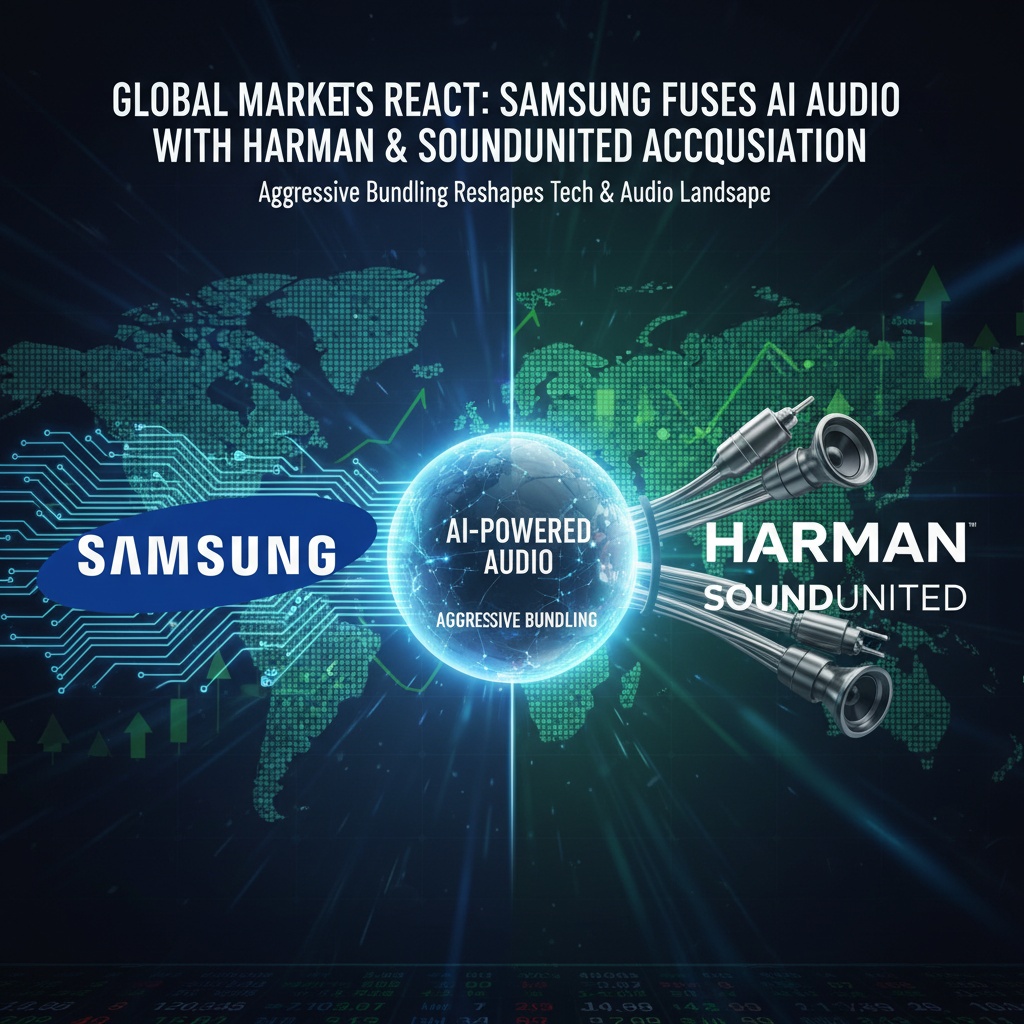*Source: https://www.yna.co.kr/view/AKR20250924023100003

● Harman Snaps Up Sound United for 350M, Turbocharges Samsung AI Audio Empire
Harman Acquires Sound United (2025) — A Practical Interpretation Through the Lens of Global Economy & M&A and AI Trends
What this piece covers: the acquisition overview and financial implications, market reshaping outlook via strategic synergies between Samsung Electronics and Harman, the often-overlooked “real monetization pathways” and “competitive advantages from an AI and Fourth Industrial Revolution perspective,” and the risks and action plans investors and companies must check immediately.
Past (Timeline) — From the Starting Point to Now
2017: Samsung Electronics invested about 9 trillion won to acquire Harman, establishing Harman as a forward base for its automotive and audio strategy.
2020–2024: Harman expanded market share in portable audio and in-vehicle sound while maintaining the strength of its premium brand portfolio.
September 24, 2025: Harman completed the acquisition of the audio division of U.S.-based Masimo (Sound United) for $350 million (approximately 500 billion won).
Present (Deal Details) — What Was Acquired
Acquisition target: Sound United (brands: Bowers & Wilkins, Denon, Marantz, Polk, Definitive Technology, etc.).
Price and structure: Reported as a $350 million cash-based acquisition; Sound United will be operated as an independent strategic business unit within Harman’s Lifestyle division.
Harman’s existing portfolio: Combined with JBL, Harman Kardon, AKG, Infinity, etc., this enhances portfolio completeness across portable, headphones, true wireless earbuds, and premium speakers.
Key Points Others Miss (Exclusive Insights)
Implications of the purchase price: $350 million represents an “attractive valuation” relative to brand equity, signaling potential for rapid value realization through post-merger integration and cross-selling (product/service bundling).
Automotive audio integration opportunity: As a powerhouse in car audio, Harman can convert premium brands like B&W into in-vehicle luxury options (AVM + sound packages) to lift average selling price (ASP).
Harman–Samsung device bundling strategy: Providing an exclusive premium audio experience across the Galaxy, Samsung TV, QLED, and SmartThings ecosystem can create a recurring revenue structure (hardware + subscriptions) through manufacturing–service convergence.
Data and AI monetization points: Aggregating each brand’s sound profiles, usage patterns, and room environment data opens opportunities to monetize AI-driven personalized audio DSP and recommendations/firmware upgrades as paid services.
Supply chain and components impact: With Harman’s purchasing scale, lower component procurement costs (drivers, D/A chips, Bluetooth SoCs) can translate into improved margins on premium products.
Integration and Execution Roadmap — 2025–2027
Phase 1 (0–6 months): Prevent customer and channel churn by preserving brand independence and ensuring retention of key talent.
Phase 2 (6–18 months): Integrate supply chains, co-procure components, and merge R&D roadmaps — especially drive a common platform for Bluetooth/codecs, ANC, and wireless transmission technologies.
Phase 3 (12–36 months): Expand bundling with Samsung devices and automotive OEM partnerships; launch AI-based sound personalization services to develop subscription revenue models.
Performance metrics: Use premium ASP uplift, cross-sell ratios by product, subscription conversion rates, and component cost savings as KPIs, targeting ROIC improvement within 18–36 months.
Market Impact (Global Economy and Audio Market Perspective) — 2025–2029
Market size outlook: As reported, the consumer audio market is projected to expand from about $60.8 billion in 2025 to $70.0 billion by 2029.
Consolidation accelerates: This deal could be a catalyst for further M&A in the global audio industry.
Pricing and positioning: The combination of Harman and Sound United strengthens price defense in the premium category, intensifying marketing and R&D pressure on competitors.
Competitor responses: Sony, Bose, and Chinese players (e.g., Hisense, Xiaomi audio lines) are likely to respond with technology/brand differentiation or aggressive value pricing.
AI Trends & Fourth Industrial Revolution Perspective — Why This Is Not Just an Audio M&A
AI-based personalization: A “personal sound engine” that infers a user’s hearing characteristics, listening history, and room conditions to automatically adjust EQ/DSP is core to premium differentiation.
Generative AI and audio content: Integrating AI-generated audio tuning, soundscapes, and personalized music mixes into the brand experience expands into subscription and content revenues.
Edge–cloud DSP division of labor: Combining ultra-low-latency on-device DSP with cloud-based AI analytics enables performance gains and continuous service upgrades.
Automotive–smarthome convergence: Managing unified sound profiles across vehicles, TVs, and smart speakers strengthens consumer lock-in.
Semiconductor and chip sourcing importance: Securing high-performance audio DAC/ADCs and AI accelerator chips becomes a key competitive factor in the Fourth Industrial Revolution era.
Risks (Must Check)
Brand positioning conflicts: Prevent internal cannibalization when consolidating multiple premium brands.
Integration costs: Brand, channel, and R&D integration may require higher-than-expected costs and time.
Regulatory and antitrust review: While antitrust risk appears low by region (notably the EU and U.S.), ongoing monitoring is necessary.
FX and macro risks: USD–KRW volatility directly affects acquisition costs and profitability.
Talent attrition: Loss of key engineers and designers can be fatal to maintaining brand quality.
Practical Checklist for Companies and Investors
Companies (executives): 1) Clearly define 24-month plans and KPIs by brand.
Companies (product teams): 2) Elevate AI personalization and edge DSP roadmaps to top priority.
Investors (shareholders/analysts): 3) Request analyses of cost structure changes from the acquisition and sensitivity across integration scenarios (best/base/worst).
Supply chain managers: 4) Reassess long-term contracts for critical components and prepare cost-reduction scenarios.
Marketing: 5) Segment upmarket and downmarket positioning strategies across the brand portfolio.
Policy and National Perspective
Global economic perspective: Overseas M&A by Korean companies that secures technology and brands can positively impact national competitiveness (exports and brand equity).
Industrial policy: Fostering semiconductor and AI talent, protecting audio-related IP, and supporting standardization are necessary to secure long-term competitiveness.
< Summary >
Harman’s acquisition of Sound United is not merely a brand expansion but an ecosystem approach combined with Samsung Electronics, with strong potential for monetization (device bundling, automotive options, and AI-based subscriptions).
The purchase price is attractive from a valuation standpoint, and the keys are component cost reductions through integration, ASP uplift, and transition to subscription models.
The biggest game changers are AI personalization, edge DSP, and generative audio content; those who invest and commercialize quickly in these areas will win the premium audio market.
Investors and management should run detailed scenario analyses on integration costs, brand stewardship, and regulatory risks, and reprioritize AI, chip, and data strategies.
[Related articles…]
Harman’s Acquisition of Sound United Reshapes Global Audio
Competition Accelerates in the Premium Audio Market After the B&W Acquisition



